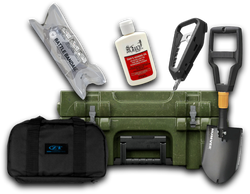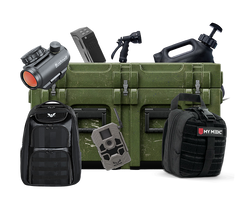How to Tell the Age of a Musket Ball
Table of Contents
- Introduction
- The Anatomy of a Musket Ball
- Methods for Determining the Age of a Musket Ball
- Practical Tips for Metal Detecting and Collecting Musket Balls
- Conclusion
- FAQ
Introduction
Imagine uncovering a small, round object while exploring a historical battlefield or during a leisurely day of metal detecting. It's a musket ball, a relic of a time when firearms were the primary tools of warfare. But how can you determine its age? This question captivates historians, collectors, and enthusiasts alike. Knowing how to tell the age of a musket ball not only enhances your understanding of its historical context but also adds depth to your collecting or detecting experience.
Musket balls have a rich history, dating back to the early 15th century when they were first used in handgonnes. They became especially significant during key historical events such as the American Revolutionary War and the Civil War. As a result, these artifacts are frequently discovered across various terrains, offering a tangible connection to the past. The ability to accurately assess the age of a musket ball can significantly increase its value and historical relevance.
In this comprehensive guide, we will explore the methods for determining the age of musket balls, including physical characteristics, manufacturing techniques, and historical context. We will delve into the science behind lead aging, discuss the various types of musket balls, and provide practical tips for identifying and dating these intriguing pieces of history. By the end of this post, you'll have a well-rounded understanding of not just how to tell the age of a musket ball, but also the importance of these artifacts in preserving our shared heritage.
The Anatomy of a Musket Ball
Before we dive into the age-determining methods, it’s crucial to understand the basic anatomy and characteristics of musket balls. Musket balls are typically made of lead, a dense and malleable metal that was favored for its weight and ability to be easily molded. They were used primarily in smoothbore firearms, which were common from the 15th to the 19th centuries.
Key Characteristics to Observe
-
Material Composition: Most musket balls are made of lead, but some may have traces of other materials, such as tin. Lead balls are soft and can be scratched easily, revealing a shiny silver interior.
-
Diameter and Weight: Musket balls typically range from 0.39 inches to 0.80 inches in diameter. Measuring the diameter can give clues about the type of firearm it was intended for. For instance, the British Brown Bess musket used a 0.693-inch diameter ball, while French Charleville muskets used a 0.63-inch ball.
-
Casting Marks: Look for mold seams, sprue marks, and medial ridges that indicate the ball was cast in a two-part mold. These imperfections can help verify authenticity and provide clues about the manufacturing period.
-
Surface Features: Over time, lead develops a patina, often appearing dull or with a white or grey oxidized coating. This patina can indicate how long the ball has been buried and its exposure to different soil conditions.
Historical Context of Musket Balls
Understanding the historical context can also aid in dating musket balls. For example, certain patterns of manufacturing or styles of balls can be traced to specific eras or conflicts. The transition from smoothbore muskets to rifled firearms in the mid-19th century dramatically changed the design and usage of projectiles, leading to the decline of traditional musket balls.
Methods for Determining the Age of a Musket Ball
Now that we have established an understanding of what musket balls are, let’s explore the methods for determining their age.
1. Visual Inspection
The first step in identifying the age of a musket ball is visual inspection. This involves examining the ball for specific characteristics:
-
Mold Seams: Older musket balls often exhibit less refined mold seams due to the manufacturing techniques of the time. A pronounced seam may indicate an older ball.
-
Surface Patina: As mentioned earlier, a well-weathered surface with signs of oxidation can indicate age. If the ball appears shiny and new, it may be a reproduction or a more modern find.
-
Casting Marks: Look for remnants of the sprue where the molten lead was poured into the mold. The way this mark appears can provide insights into whether the ball was made in a more primitive or advanced manner.
2. Measuring Diameter and Weight
Using precision measuring tools like calipers, measure the diameter of the musket ball. This measurement can help identify the type of musket it was designed for, correlating with specific historical periods.
Additionally, weighing the ball can provide crucial information. A formula known as the Sivilich Formula can estimate the diameter of a non-spherical ball based on its weight. This formula is particularly useful for balls that may have been damaged or misshapen over time.
3. Analyze Material Composition
Determining the material composition can also aid in dating musket balls. Authentic musket balls are typically made of lead, while fakes or more recent replicas may incorporate different metals or alloys.
You can conduct a simple test using a magnet. Lead is non-magnetic, so if your musket ball is attracted to the magnet, it may not be a genuine lead ball.
4. Research Historical Context
To accurately determine the age of a musket ball, you need to understand the context in which it was used. Research the historical significance of the area where you found the ball. If the ball was discovered on a battlefield site, historical records can help narrow down the timeframe of its use.
5. Consult Experts and Resources
If you are still uncertain about the age of your musket ball, consider reaching out to historians, archaeologists, or collectors who specialize in military artifacts. They may provide insights based on their expertise and experience.
Moreover, various books and online resources are available that delve into the specifics of musket ball identification and dating. This additional research can help solidify your understanding of your find.
Practical Tips for Metal Detecting and Collecting Musket Balls
For enthusiasts who enjoy metal detecting and collecting musket balls, here are some practical tips to enhance your experience:
-
Choose the Right Equipment: Invest in a quality metal detector that can efficiently identify lead objects. Ensure it's equipped with a discrimination feature to help differentiate between various metals.
-
Research Locations: Focus on historically significant sites, such as battlefields, old military installations, or areas known for historical reenactments.
-
Join Communities: Engage with local clubs or online forums dedicated to metal detecting and historical artifacts. Sharing insights and experiences can enhance your knowledge and skills.
-
Handle with Care: When you discover a musket ball, handle it gently to avoid damaging its surface. Clean it carefully using methods that do not strip away the patina or historical value.
-
Document Your Finds: Keep a record of where and when you found each musket ball, along with any relevant historical context. This documentation will be invaluable for future reference and for enhancing the historical narrative of your collection.
Conclusion
Understanding how to tell the age of a musket ball is not just about identifying an artifact; it’s about connecting with history and preserving the narratives that come along with these remnants of the past. By employing methods such as visual inspection, measuring diameter and weight, analyzing material composition, researching historical context, and consulting experts, you can gain a deeper appreciation for your finds and their significance.
As you embark on your journey of discovery, remember that each musket ball carries with it a story waiting to be uncovered. Whether you are a seasoned collector or a curious enthusiast, the skills you develop in identifying and dating these artifacts will enhance your appreciation for history and your place within it.
For those interested in further enhancing their preparedness and tactical skills, consider exploring the Crate Club’s subscription services. With curated tactical gear and survival tools delivered to your doorstep each month, you can equip yourself with the necessary tools for your next adventure.
Explore the Crate Club subscriptions here and discover their shop for an array of premium gear here.
FAQ
Q1: What is a musket ball made of?
A1: Musket balls are primarily made of lead, although some may contain small amounts of tin or other materials. Lead was favored for its density and malleability.
Q2: How can I tell if my musket ball is authentic?
A2: Authentic musket balls typically show signs of casting marks, surface patina, and are non-magnetic. Conducting a visual inspection and measuring the diameter and weight can aid in determining authenticity.
Q3: What types of firearms used musket balls?
A3: Musket balls were primarily used in smoothbore muskets, which were common from the 15th to the 19th centuries. They were also used in firearms like pistols and rifles during that era.
Q4: Where can I find musket balls?
A4: Musket balls can be found in historically significant areas such as battlefields, old military sites, and locations known for historical reenactments. Metal detecting in these areas can yield exciting discoveries.
Q5: How can I improve my skills in identifying historical artifacts?
A5: Engaging with local clubs, participating in online forums, and conducting thorough research on historical artifacts will enhance your skills. Networking with experienced collectors can also provide valuable insights.
Comparte este artículo



